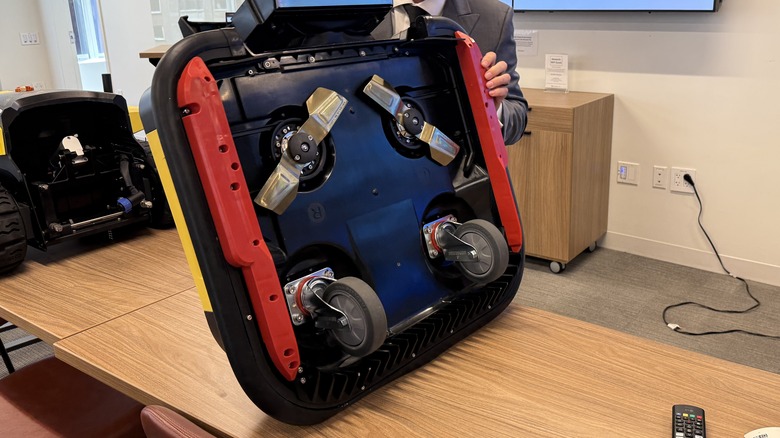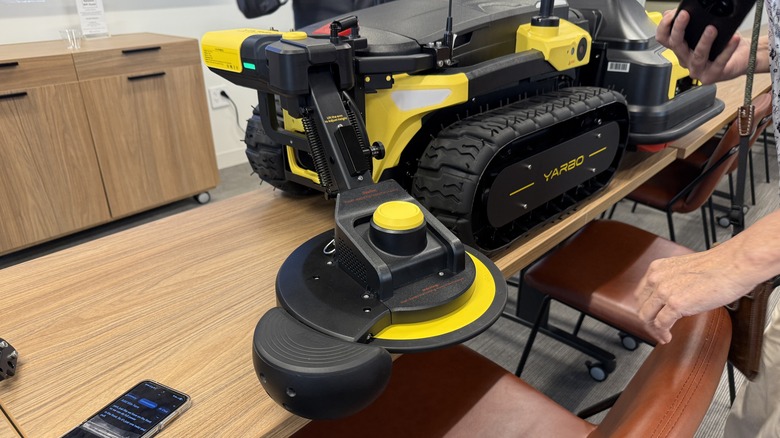
Robot lawnmowers are making their presence known in the U.S., but they're still a bit of a novelty on these shores, and there are some things you should know about robot mowers before you buy one. I've been testing quite a few of them and they're always a conversation starter. Yarbo is one such manufacturer and it has two things that make its product unique in that industry. The first is that they're very robust, which is another way of saying they're extremely heavy. Most robot lawnmowers arrive
in a box that weighs 40-60 pounds. Yarbo arrives in multiple boxes weighing close to 100 pounds each.
The second is what brought me to New York City to attend a showcase for the brand — Yarbo mowers aren't just mowers. They're modular. If you have a Yarbo Core, you can attach a Lawn mower, a leaf blower, or a snow blower module to accomplish those tasks — they're ready to help you with your yard work, year-round.
This modular approach is a big part of the reason why Yarbo is as heavy as it is. It needs bulk to push around snow — not so much with a mower module. But its added bulk adds certain other capabilities that are beneficial to lawn maintenance. All that being said, Yarbo had some videos to show the media demonstrating two pretty neat devices.
Read more: 6 Of The Best Gadgets For Bicycles, According To Cyclists
The Lawnmower Pro

Yarbo's first generation mower module used a fairly standard mechanism to cut grass. Most robot mowers use a spinning disc with razor blades that protrude out in order to trim grass. That's why robot mowers are designed to run several times per week, nipping the tips off your grass rather than cutting it like you would with a standard (non-robotic) mower.
The Lawnmower Pro changes that up by adding more power to the module and making straight blades an option. Straight blades allow you to cut longer grass less often. The blades mulch the grass better as well. The trick is, more power is required to spin them, so the motors needed higher output. All the same, while the original lawnmower can cover 6 acres twice per week, the Lawnmower Pro can cover up to 12 acres once per week (which is often enough with the straight blades). You're effectively doubling the ground covered by replacing the blades.
The lawnmower pro can also cut closer to the ground. While the Lawnmower can cut grass down to 1.2 inches in length, the Lawnmower Pro can get down as low as .8 inches. This is more relevant to finely manicured lawns, like what you would find on a golf course.
Yarbo's Trimmer Arm

Along with the Lawnmower Pro, Yarbo showed us its trimmer attachment which is an industry first. You can think of the trimmer like a weed whacker, weed eater, or string strimmer — it depends on your region, but they're all the same thing. Like the Lawnmower, the trimmer can work autonomously too, completely unsupervised.
If you're like me, you're probably wondering about safety. Autonomous mowers keep their blades spinning below the deck making them safe. A string trimmer on the other hand is free spinning which can be dangerous. Fortunately, Yarbo thought of that.
First of all, the string trimmer has a solid disc above it that prevents the trimmer from getting too close to barriers like walls and chain link fences (and ankles), but it also prevents accidental hits from the trimmer. The Yarbo mower also has 360 vision sensors and will shut down the trimmer if a living thing is detected within several yards of the mower, so in theory it should all be safe.
The mower can also use those cameras and the trimmer to reverse into areas that are normally out of reach for a robot mower. That's valuable because as cool as robot mowers can be, they're not 100% solutions for lawn care. Mowers lack the ability to get into tight spaces, so you still have to maintain those spots on your own. The trimmer attachment on the Yarbo cuts down on that considerably.
Not Necessarily Real-World Performance

Of course, there are two big caveats to all of this. First, we need to wait to see how these devices perform in the real world. Demos are one thing and video demos are an even greater step removed from reality, so how these devices hold up to stress testing will tell the tale. Fortunately, I have a Yarbo review unit at my home and I'm ready to test these devices out as soon as they ship. The downside is that it's almost September, and the trimmer units won't be ready to ship until Q4. In Chicago, I'd have more use for the snowblower attachment than the trimmer attachment by that point.
The second caveat is definitely not a small one. The Yarbo Mower and trimmer package which includes the Yarbo Core to drive both of the units costs $5,798. That is not a small investment. In fact, it's among the most expensive robot lawnmowers in the market. It's almost twice what a John Deer riding mower with a 42-inch deck costs at Home Depot.
But, ultimately, it's up to you to decide if your lawn is worth such an investment. I'm looking forward to trying out the trimmer on my Yarbo unit, likely when spring rolls around. In the meantime, both of these attachments are great in theory, and I'm excited to put them through their paces.
Want the latest in tech and auto trends? Subscribe to our free newsletter for the latest headlines, expert guides, and how-to tips, one email at a time.
Read the original article on SlashGear.













